Heat Transfer Impacts on Maxwell Nanofluid Flow over a Vertical Moving Surface with MHD Using Stochastic Numerical Technique via Artificial Neural Networks
Abstract
:1. Introduction
- A new AI-based intelligent computing methodology via Levenberg–Marquardt back propagation with neural networks (TLMB-NN) is used to viably explore the solution dynamics for the heat transfer of Maxwell base fluid flow of nanomaterials (HTM-BFN) with MHD;
- By providing the required equivalent modification, the mathematical modeling of the novel design HTM-BFN in expressions of PDEs has transformed to similar non-linear ODEs;
- Based on Hartmann number, Grashof numbers, concentration Grashoff factor, Lewis number, Brownian motion factor, Thermophoresis factor, Eckert number, Prandtl number, and other characteristics, the Adam’s solver is exploited to build a dataset for the designed TLMB-NN as an alternative to the dynamic of HTM-BFN;
- Modeling HTM-BFN for various scenarios by employing the TLMB-NN testing, validation, and training samples based procedures, and evaluation with orientation results rationalizes its perfection; and
- The applicability of the suggested TLMB-NN to successfully represent the HTM-BFN model has supported by convergence graphs of calculated MSE, fitness, histograms, and regression metrics.
2. Mathematical Interpretation and Flow Assessment
3. Solution Methodology
4. Results and Discussion
5. Conclusions
Author Contributions
Funding
Institutional Review Board Statement
Informed Consent Statement
Data Availability Statement
Acknowledgments
Conflicts of Interest
Nomenclature
| x, y (m) | Cartesian coordinate system | GT | Thermal Grashof number |
| υ (m2 s−1) | Kinematic viscosity | GC | Concentration Grashoff parameter |
| qw (wm−2) | Surface heat flux | R | Radiation parameter |
| σ* | Stefann Boltzman constant | Pr | Prandtl number |
| DB | Brownian diffusion coefficient | EC | Eckert number |
| Le | Lewis number | k* | Coefficient of Mean absorption |
| Nt | Thermophoresis factor | Nb | Brownian motion parameter |
| β | Deborah number | hm (kgs−1 m−2) | Surface mass flux |
| Uw, Ue | Dimensionless constants | U0 | Characteristic velocity |
| H | Heat absorption factor | Nux | Nusselt number |
| DT | Thermophoretic diffusion coefficient | MSE | Mean square error |
| MHD | Magnetohydrodynamics | ANN | Artificial neural networks |
| ODEs | Ordinary differential equations | PDEs | Partial differential equations |
| HTM-BFN | Heat transfer of Maxwell base fluid flow of nanomaterials | TLMB-NN | Technique of Levenberg–Marquardt back propagation with neural networks |
References
- Parker, D.B. August. A comparison of algorithms for neuron-like cells. AIP Conf. Proc. 1986, 151, 327–332. [Google Scholar]
- Raja, M.A.Z.; Khan, Z.; Zuhra, S.; Chaudhary, N.I.; Khan, W.U.; He, Y.; Islam, S.; Shoaib, M. Cattaneo-christov heat flux model of 3D hall current involving biconvection nanofluidic flow with Darcy-Forchheimer law effect: Backpropagation neural networks approach. Case Stud. Therm. Eng. 2021, 26, 101168. [Google Scholar] [CrossRef]
- Shoaib, M.; Raja, M.A.Z.; Kha, M.A.R.; Farhat, I.; Awan, S.E. Neuro-Computing Networks for Entropy Generation under the Influence of MHD and Thermal Radiation. Surf. Interfaces 2021, 25, 101243. [Google Scholar] [CrossRef]
- Khan, R.A.; Ullah, H.; Raja, M.A.Z.; Khan, M.A.R.; Islam, S.; Shoaib, M. Heat transfer between two porous parallel plates of steady nano fludis with Brownian and Thermophoretic effects: A new stochastic numerical approach. Int. Commun. Heat Mass Transf. 2021, 126, 105436. [Google Scholar] [CrossRef]
- Sabir, Z.; Raja, M.A.Z.; Guirao, J.L.G.; Shoaib, M. Integrated intelligent computing with neuro-swarming solver for multi-singular fourth-order nonlinear Emden–Fowler equation. Comput. Appl. Math. 2020, 39, 307. [Google Scholar] [CrossRef]
- Uddin, I.; Ullah, I.; Raja, M.A.Z.; Shoaib, M.; Islam, S.; Muhammad, T. Design of intelligent computing networks for numerical treatment of thin film flow of Maxwell nanofluid over a stretched and rotating surface. Surf. Interfaces 2021, 24, 101107. [Google Scholar] [CrossRef]
- Choi, S.U.; Eastman, J.A. Enhancing Thermal Conductivity of Fluids with Nanoparticles; (No. ANL/MSD/CP-84938; CONF-951135-29); Argonne National Lab.: Lemont, IL, USA, 1995. [Google Scholar]
- Yu, W.; France, D.M.; Choi, S.U.S.; Routbort, J.L. Review and Assessment of Nanofluid Technology for Transportation and Other Applications; Report No. ANL/ESD/07-9; Argonne National Lab.: Argonne, IL, USA, 2007. [Google Scholar]
- Nayak, M.; Akbar, N.S.; Pandey, V.S.; Khan, Z.; Tripathi, D. 3D free convective MHD flow of nanofluid over permeable linear stretching sheet with thermal radiation. Powder Technol. 2017, 315, 205–215. [Google Scholar] [CrossRef]
- Sheikholeslami, M.; Hayat, T.; Alsaedi, A. MHD free convection of Al2O3–water nanofluid considering thermal radiation: A numerical study. Int. J. Heat Mass Transf. 2016, 96, 513–524. [Google Scholar] [CrossRef]
- Nima, N.I.; Salawu, S.O.; Ferdows, M.; Shamshuddin, M.D.; Alsenafi, A.; Nakayama, A. Melting effect on non-Newtonian fluid flow in gyrotactic microorganism saturated non-darcy porous media with variable fluid properties. Appl. Nanosci. 2020, 10, 3911–3924. [Google Scholar] [CrossRef]
- Eastman, J.; Phillpot, S.; Choi, S.; Keblinski, P. Thermal Transport in Nanofluids. Annu. Rev. Mater. Res. 2004, 34, 219–246. [Google Scholar] [CrossRef]
- Ogunseye, H.A.; Salawu, S.O.; Tijani, Y.O.; Riliwan, M.; Sibanda, P. Dynamical analysis of hydromagnetic Brownian and thermophoresis effects of squeezing Eyring–Powell nanofluid flow with variable thermal conductivity and chemical reaction. Multidiscip. Model. Mater. Struct. 2019, 15, 1100–1120. [Google Scholar] [CrossRef]
- Salawu, S.; Ogunseye, H. Entropy generation of a radiative hydromagnetic Powell-Eyring chemical reaction nanofluid with variable conductivity and electric field loading. Results Eng. 2020, 5, 100072. [Google Scholar] [CrossRef]
- Maleki, H.; Alsarraf, J.; Moghanizadeh, A.; Hajabdollahi, H.; Safaei, M.R. Heat transfer and nanofluid flow over a porous plate with radiation and slip boundary conditions. J. Central South Univ. 2019, 26, 1099–1115. [Google Scholar] [CrossRef]
- Rashidi, M.M.; Momoniat, E.; Rostami, B. Analytic Approximate Solutions for MHD Boundary-Layer Viscoelastic Fluid Flow over Continuously Moving Stretching Surface by Homotopy Analysis Method with Two Auxiliary Parameters. J. Appl. Math. 2012, 19, 780415. [Google Scholar] [CrossRef]
- Pavlov, K.B. Magnetohydrodynamic flow of an incompressible viscous fluid caused by deformation of a plane surface. Magn. Gidrodin. 1974, 4, 146–147. [Google Scholar]
- Chakrabarti, A.; Gupta, A.S. Hydromagnetic flow and heat transfer over a stretching sheet. Q. Appl. Math. 1979, 37, 73–78. [Google Scholar] [CrossRef] [Green Version]
- Daniel, Y.S.; Aziz, Z.A.; Ismail, Z.; Salah, F. Effects of thermal radiation, viscous and Joule heating on electrical MHD nanofluid with double stratification. Chin. J. Phys. 2017, 55, 630–651. [Google Scholar] [CrossRef]
- Gupta, M.; Singh, V.; Kumar, R.; Said, Z. A review on thermophysical properties of nanofluids and heat transfer applications. Renew. Sustain. Energy Rev. 2017, 74, 638–670. [Google Scholar] [CrossRef]
- Asadi, A.; Pourfattah, F.; Szilágyi, I.M.; Afrand, M.; Żyła, G.; Ahn, H.S.; Wongwises, S.; Nguyen, H.M.; Arabkoohsar, A.; Mahian, O. Effect of sonication characteristics on stability, thermophysical properties, and heat transfer of nanofluids: A comprehensive review. Ultrason. Sonochem. 2019, 58, 104701. [Google Scholar] [CrossRef]
- Rudyak, V.Y.; Minakov, A.V. Thermophysical properties of nanofluids. Eur. Phys. J. E 2018, 41, 15. [Google Scholar] [CrossRef]
- Madhu, M.; Kishan, N.; Chamkha, A.J. Unsteady flow of a Maxwell nanofluid over a stretching surface in the presence of magnetohydrodynamic and thermal radiation effects. Propuls. Power Res. 2017, 6, 31–40. [Google Scholar] [CrossRef]
- Khan, Z.; Rasheed, H.U.; Alkanhal, T.A.; Ullah, M.; Khan, I.; Tlili, I. Effect of magnetic field and heat source on Upper-convected-maxwell fluid in a porous channel. Open Phys. 2018, 16, 917–928. [Google Scholar] [CrossRef]
- Nadeem, S.; Akhtar, S.; Abbas, N. Heat transfer of Maxwell base fluid flow of nanomaterial with MHD over a vertical moving surface. Alex. Eng. J. 2020, 59, 1847–1856. [Google Scholar] [CrossRef]
- Sakiadis, B.C. Boundary-layer behavior on continuous solid surfaces: III. The boundary layer on a continuous cylindrical surface. AIChE J. 1961, 7, 467–472. [Google Scholar] [CrossRef]
- Merkin, J.H. The effect of buoyancy forces on the boundary-layer flow over a semi-infinite vertical flat plate in a uniform free stream. J. Fluid Mech. 1969, 35, 439–450. [Google Scholar] [CrossRef]
- Wilks, G. The flow of a uniform stream over a semi-infinite vertical flat plate with uniform surface heat flux. Int. J. Heat Mass Transf. 1974, 17, 743–753. [Google Scholar] [CrossRef]
- Ghalambaz, M.; Groşan, T.; Pop, I. Mixed convection boundary layer flow and heat transfer over a vertical plate embedded in a porous medium filled with a suspension of nano-encapsulated phase change materials. J. Mol. Liq. 2019, 293, 111432. [Google Scholar] [CrossRef]
- Mehryan, S.A.M.; Ghalambaz, M.; Gargari, L.S.; Hajjar, A.; Sheremet, M. Natural convection flow of a suspension containing nano-encapsulated phase change particles in an eccentric annulus. J. Energy Storage 2020, 28, 101236. [Google Scholar] [CrossRef]
- Bachok, N.; Jaradat, M.A.; Pop, I. A similarity solution for the flow and heat transfer over a moving permeable flat plate in a parallel free stream. Heat Mass Transf. 2011, 47, 1643–1649. [Google Scholar] [CrossRef]
- Sadeghy, K.; Najafi, A.-H.; Saffaripour, M. Sakiadis flow of an upper-convected Maxwell fluid. Int. J. Non Linear Mech. 2005, 40, 1220–1228. [Google Scholar] [CrossRef]
- Damseh, R.A.; Shannak, B.A. Visco-elastic fluid flow past an infinite vertical porous plate in the presence of first-order chemical reaction. Appl. Math. Mech. 2010, 31, 955–962. [Google Scholar] [CrossRef]
- Nadeem, S.; Haq, R.; Khan, Z. Numerical study of MHD boundary layer flow of a Maxwell fluid past a stretching sheet in the presence of nanoparticles. J. Taiwan Inst. Chem. Eng. 2014, 45, 121–126. [Google Scholar] [CrossRef]
- Zhao, J.; Zheng, L.; Zhang, X.; Liu, F. Unsteady natural convection boundary layer heat transfer of fractional Maxwell viscoelastic fluid over a vertical plate. Int. J. Heat Mass Transf. 2016, 97, 760–766. [Google Scholar] [CrossRef]
- Bhatti, M.M.; Mishra, S.; Abbas, T.; Rashidi, M.M. A mathematical model of MHD nanofluid flow having gyrotactic microorganisms with thermal radiation and chemical reaction effects. Neural Comput. Appl. 2018, 30, 1237–1249. [Google Scholar] [CrossRef]
- Bachok, N.; Ishak, A.; Pop, I. Boundary-layer flow of nanofluids over a moving surface in a flowing fluid. Int. J. Therm. Sci. 2010, 49, 1663–1668. [Google Scholar] [CrossRef]
- Motsa, S.S.; Dlamini, P.; Khumalo, M. Spectral relaxation method and spectral quasilinearization method for solving unsteady boundary layer flow problems. Adv. Math. Phys. 2014, 2014, 341964. [Google Scholar] [CrossRef]
- Liao, S. On the homotopy analysis method for nonlinear problems. Appl. Math. Comput. 2004, 147, 499–513. [Google Scholar] [CrossRef]
- Sarif, N.; Salleh, M.Z.; Nazar, R. Numerical solution of flow and heat transfer over a stretching sheet with newtonian heating using the keller box method. Procedia Eng. 2013, 53, 542–554. [Google Scholar] [CrossRef] [Green Version]
- Wang, J.; Ye, X. A weak Galerkin finite element method for second-order elliptic problems. J. Comput. Appl. Math. 2013, 241, 103–115. [Google Scholar] [CrossRef] [Green Version]
- Umar, M.; Sabir, Z.; Raja, M.A.Z.; Shoaib, M.; Gupta, M.; Sánchez, Y.G. A stochastic intelligent computing with neuro-evolution heuristics for nonlinear sitr system of novel COVID-19 Dynamics. Symmetry 2020, 12, 1628. [Google Scholar] [CrossRef]
- Cheema, T.N.; Raja, M.A.Z.; Ahmad, I.; Naz, S.; Ilyas, H.; Shoaib, M. Intelligent computing with Levenberg-Marquardt artificial neural networks for nonlinear system of COVID-19 epidemic model for future generation disease control. Eur. Phys. J. Plus 2020, 135, 932. [Google Scholar] [CrossRef]
- Umar, M.; Raja, M.A.Z.; Sabir, Z.; Alwabli, A.S.; Shoaib, M. A stochastic computational intelligent solver for numerical treatment of mosquito dispersal model in a heterogeneous environment. Eur. Phys. J. Plus 2020, 135, 217. [Google Scholar] [CrossRef]
- Ahmed, S.I.; Faisal, F.; Shoaib, M.; Raja, M.A.Z. A new heuristic computational solver for nonlinear singular Thomas-Fermi system using evolutionary optimized cubic splines. Eur. Phys. J. Plus 2020, 135, 55. [Google Scholar] [CrossRef]
- Raja, M.A.Z.; Mehmood, A.; Khan, A.A.; Zameer, A. Integrated intelligent computing for heat transfer and thermal radiation-based two-phase MHD nanofluid flow model. Neural Comput. Appl. 2020, 32, 2845–2877. [Google Scholar] [CrossRef]
- Mehmood, A.; Haq, N.-U.; Zameer, A.; Ling, S.H.; Raja, M.A.Z. Design of neuro-computing paradigms for nonlinear nanofluidic systems of MHD Jeffery-Hamel flow. J. Taiwan Inst. Chem. Eng. 2018, 91, 57–85. [Google Scholar] [CrossRef]
- Sabir, Z.; Raja, M.A.Z.; Khalique, C.M.; Unlu, C. Neuro-evolution computing for nonlinear multi-singular system of third order Emden–Fowler equation. Math. Comput. Simul. 2021, 185, 799–812. [Google Scholar] [CrossRef]
- Sabir, Z.; Umar, M.; Guirao, J.L.G.; Shoaib, M.; Raja, M.A.Z. Integrated intelligent computing paradigm for nonlinear multi-singular third-order Emden–Fowler equation. Neural Comput. Appl. 2021, 33, 3417–3436. [Google Scholar] [CrossRef]
- Raja, M.A.Z.; Mehmood, A.; Niazi, S.A.; Shah, S.M. Computational intelligence methodology for the analysis of RC circuit modelled with nonlinear differential order system. Neural Comput. Appl. 2018, 30, 1905–1924. [Google Scholar] [CrossRef]
- Ahmad, I.; Raja, M.A.Z.; Ramos, H.; Bilal, M.; Shoaib, M. Integrated neuro-evolution-based computing solver for dynamics of nonlinear corneal shape model numerically. Neural Comput. Appl. 2021, 33, 5753–5769. [Google Scholar] [CrossRef]
- Ali, A.; Ilyas, S.U.; Garg, S.; Alsaady, M.; Maqsood, K.; Nasir, R.; Abdulrahman, A.; Zulfiqar, M.; Bin Mahfouz, A.; Ahmed, A.; et al. Dynamic viscosity of Titania nanotubes dispersions in ethylene glycol/water-based nanofluids: Experimental evaluation and predictions from empirical correlation and artificial neural network. Int. Commun. Heat Mass Transf. 2020, 118, 104882. [Google Scholar] [CrossRef]
- Jadoon, I.; Ahmed, A.; Rehman, A.U.; Shoaib, M.; Raja, M.A.Z. Integrated meta-heuristics finite difference method for the dynamics of nonlinear unipolar electrohydrodynamic pump flow model. Appl. Soft Comput. 2020, 97, 106791. [Google Scholar] [CrossRef]
- Gopal, D.; Saleem, S.; Jagadha, S.; Ahmad, F.; Almatroud, A.O.; Kishan, N. Numerical analysis of higher order chemical reaction on electrically MHD nanofluid under influence of viscous dissipation. Alex. Eng. J. 2021, 60, 1861–1871. [Google Scholar] [CrossRef]
- Shoaib, M.; Raja, M.A.Z.; Sabir, M.T.; Bukhari, A.H.; Alrabaiah, H.; Shah, Z.; Kumam, P.; Islam, S. A stochastic numerical analysis based on hybrid NAR-RBFs networks nonlinear SITR model for novel COVID-19 dynamics. Comput. Methods Programs Biomed. 2021, 202, 105973. [Google Scholar] [CrossRef] [PubMed]
- Awan, S.E.; Raja, M.A.Z.; Gul, F.; Khan, Z.A.; Mehmood, A.; Shoaib, M. Numerical Computing Paradigm for Investigation of Micropolar Nanofluid Flow Between Parallel Plates System with Impact of Electrical MHD and Hall Current. Arab. J. Sci. Eng. 2021, 46, 645–662. [Google Scholar] [CrossRef]
- Disu, A.; Dada, M. Reynold’s model viscosity on radiative MHD flow in a porous medium between two vertical wavy walls. J. Taibah Univ. Sci. 2017, 11, 548–565. [Google Scholar] [CrossRef] [Green Version]
- Amjad, M.; Zehra, I.; Nadeem, S.; Abbas, N.; Saleem, A.; Issakhov, A. Influence of Lorentz force and Induced Magnetic Field Effects on Casson Micropolar nanofluid flow over a permeable curved stretching/shrinking surface under the stagnation region. Surfaces Interfaces 2020, 21, 100766. [Google Scholar] [CrossRef]
- Awais, M.; Awan, S.E.; Raja, M.A.Z.; Shoaib, M. Effects of Gyro-Tactic Organisms in Bio-convective Nano-material with Heat Immersion, Stratification, and Viscous Dissipation. Arab. J. Sci. Eng. 2021, 46, 5907–5920. [Google Scholar] [CrossRef]
- Sheikholeslami, M.; Gerdroodbary, M.B.; Moradi, R.; Shafee, A.; Li, Z. Application of Neural Network for estimation of heat transfer treatment of Al2O3-H2O nanofluid through a channel. Comput. Methods Appl. Mech. Eng. 2019, 344, 1–12. [Google Scholar] [CrossRef]
- Mehmood, A.; Afsar, K.; Zameer, A.; Awan, S.E.; Raja, M.A.Z. Integrated intelligent computing paradigm for the dynamics of micropolar fluid flow with heat transfer in a permeable walled channel. Appl. Soft Comput. 2019, 79, 139–162. [Google Scholar] [CrossRef]
- Raja, M.A.Z.; Mehmood, A.; Ashraf, S.; Awan, K.M.; Shi, P. Design of evolutionary finite difference solver for numerical treatment of computer virus propagation with countermeasures model. Math. Comput. Simul. 2021, 193, 409–430. [Google Scholar] [CrossRef]
- Masood, Z.; Samar, R.; Raja, M.A.Z. Design of fractional order epidemic model for future generation tiny hardware implants. Future Gener. Comput. Syst. 2020, 106, 43–54. [Google Scholar] [CrossRef]
- Masood, Z.; Samar, R.; Raja, M.A.Z. Design of a mathematical model for the Stuxnet virus in a network of critical control infrastructure. Comput. Secur. 2019, 87, 101565. [Google Scholar] [CrossRef]
- Pantokratoras, A. Four usual errors made in investigation of boundary layer flows. Powder Technol. 2019, 353, 505–508. [Google Scholar] [CrossRef]
- Pantokratoras, A. A common error made in investigation of boundary layer flows. Appl. Math. Model. 2009, 33, 413–422. [Google Scholar] [CrossRef]
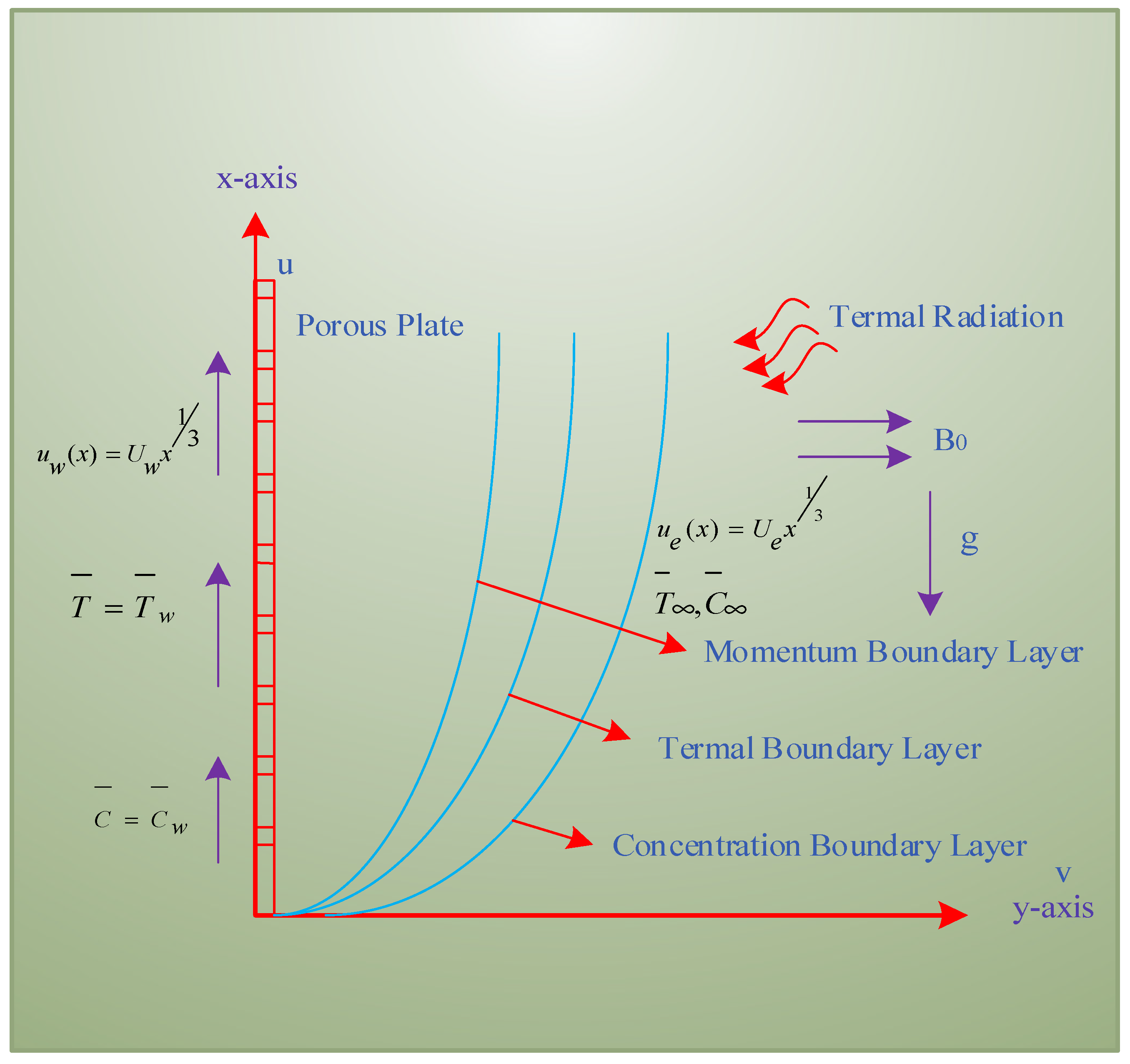

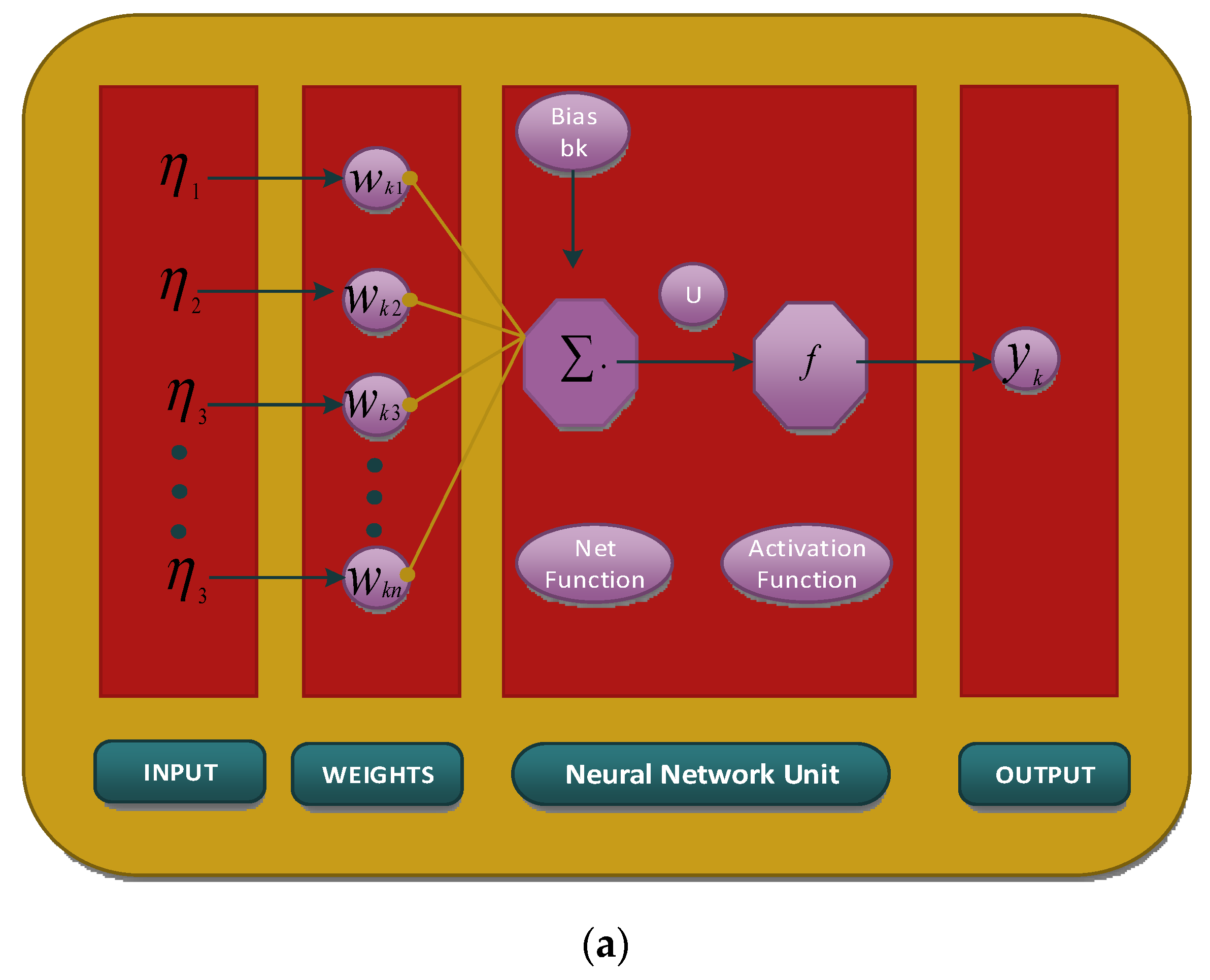


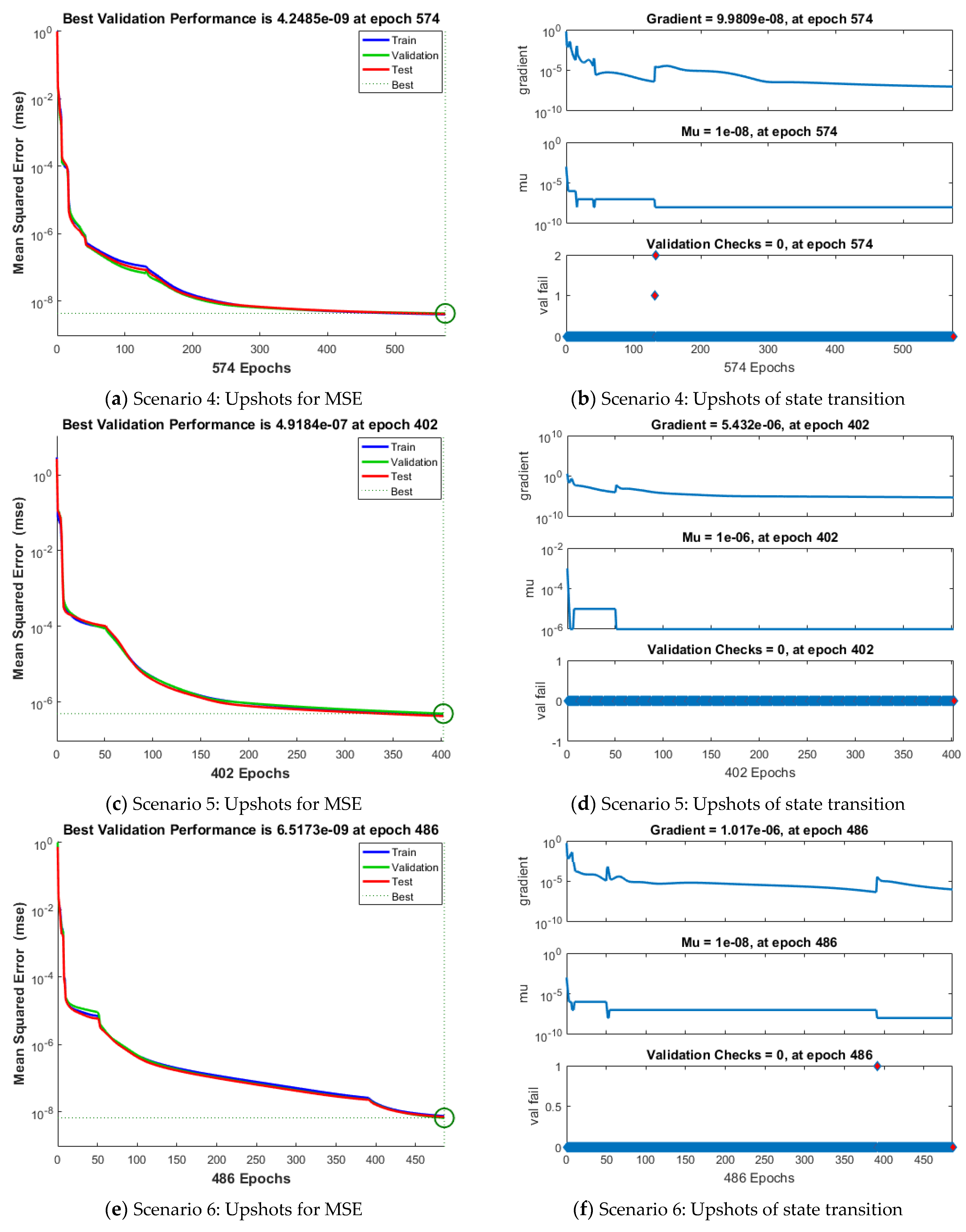
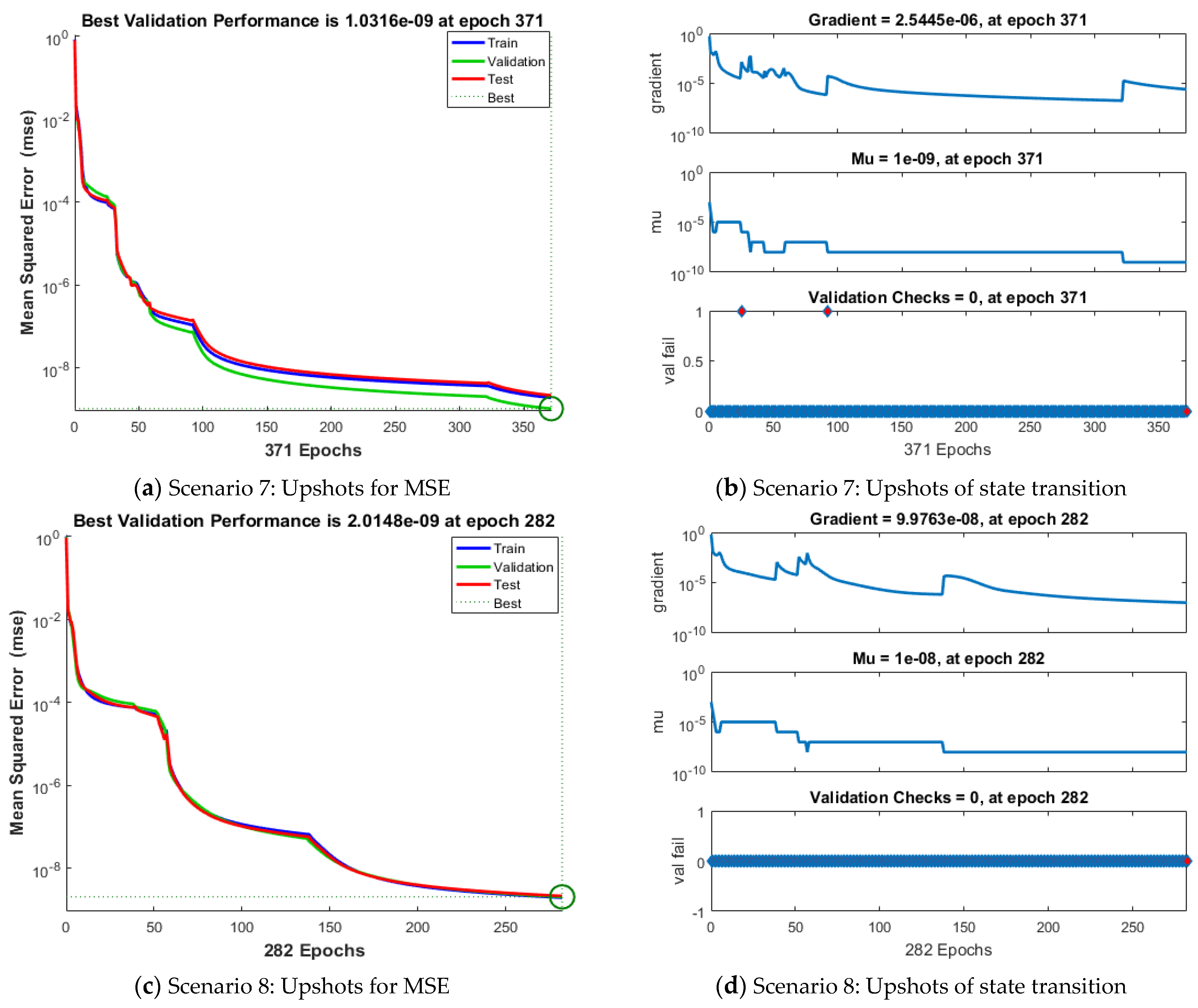
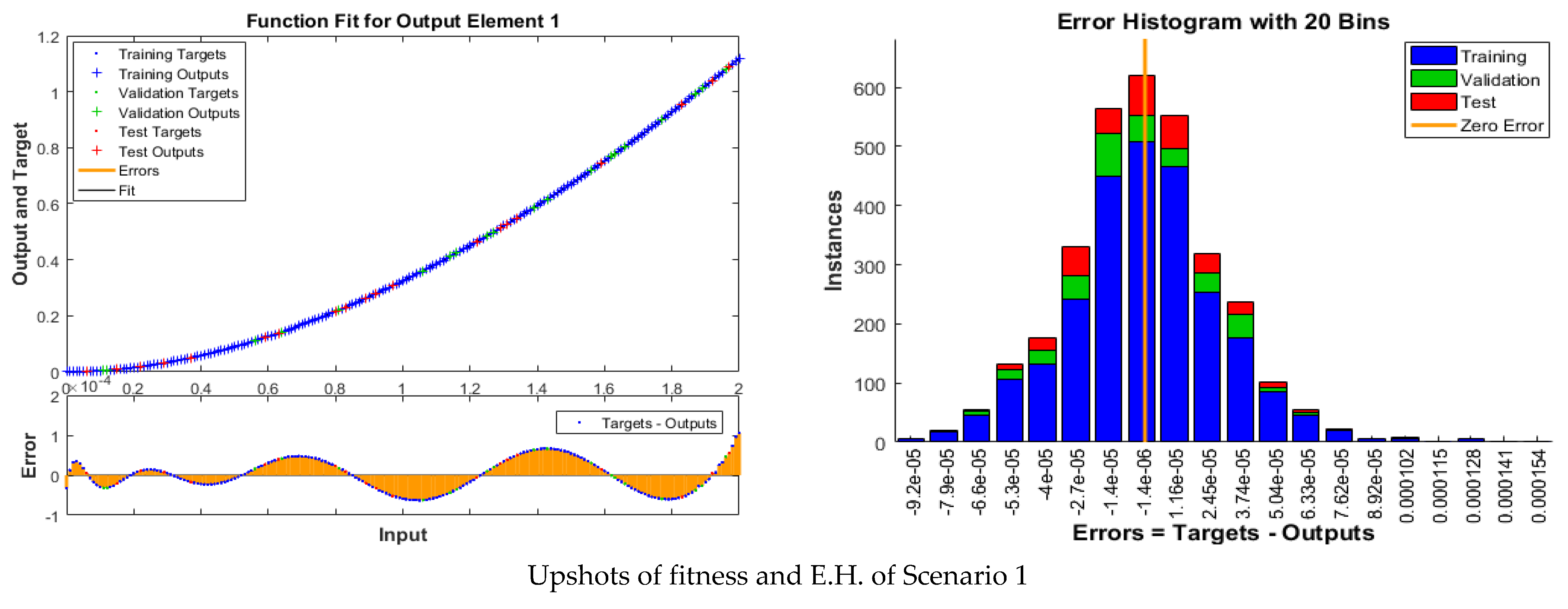
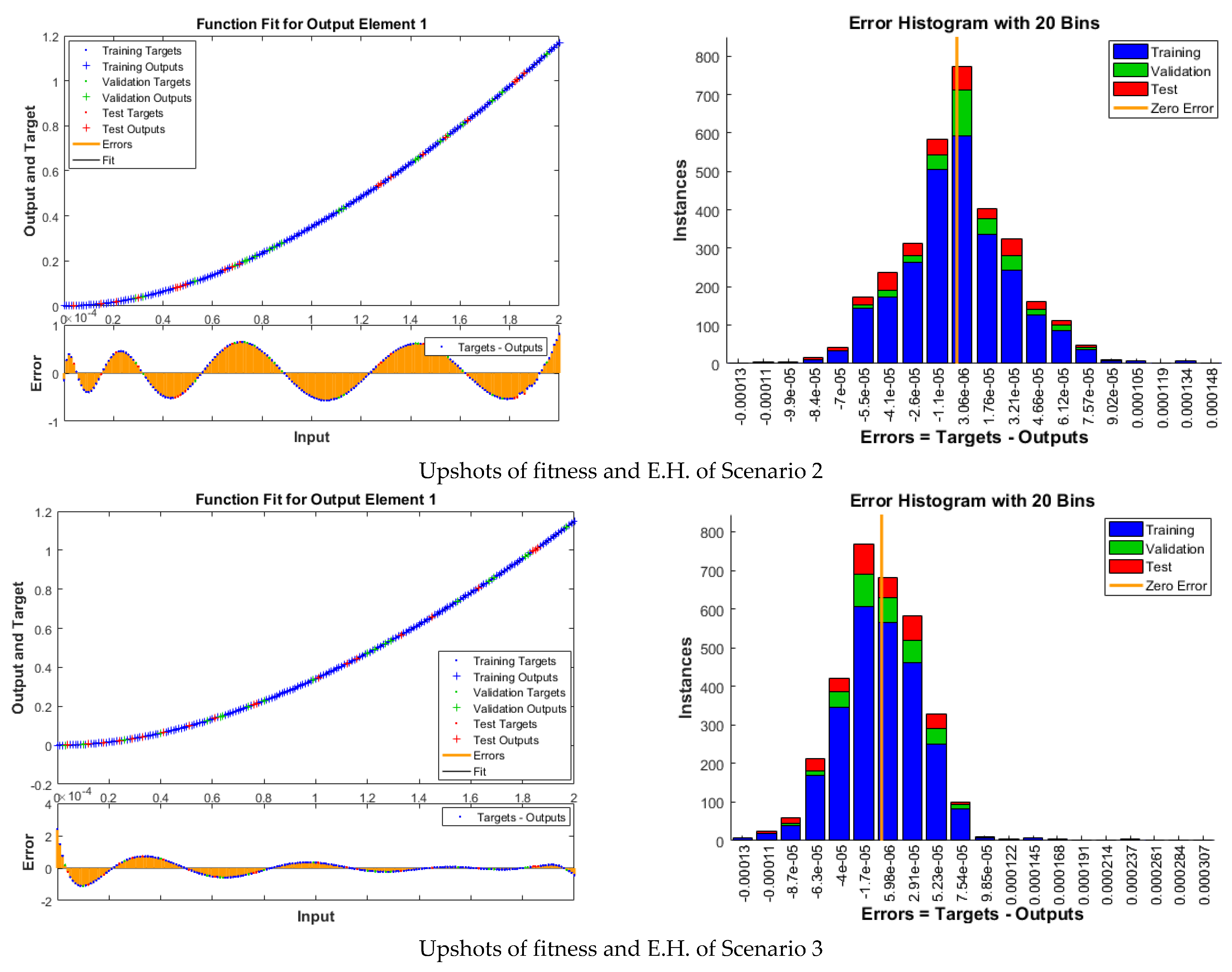
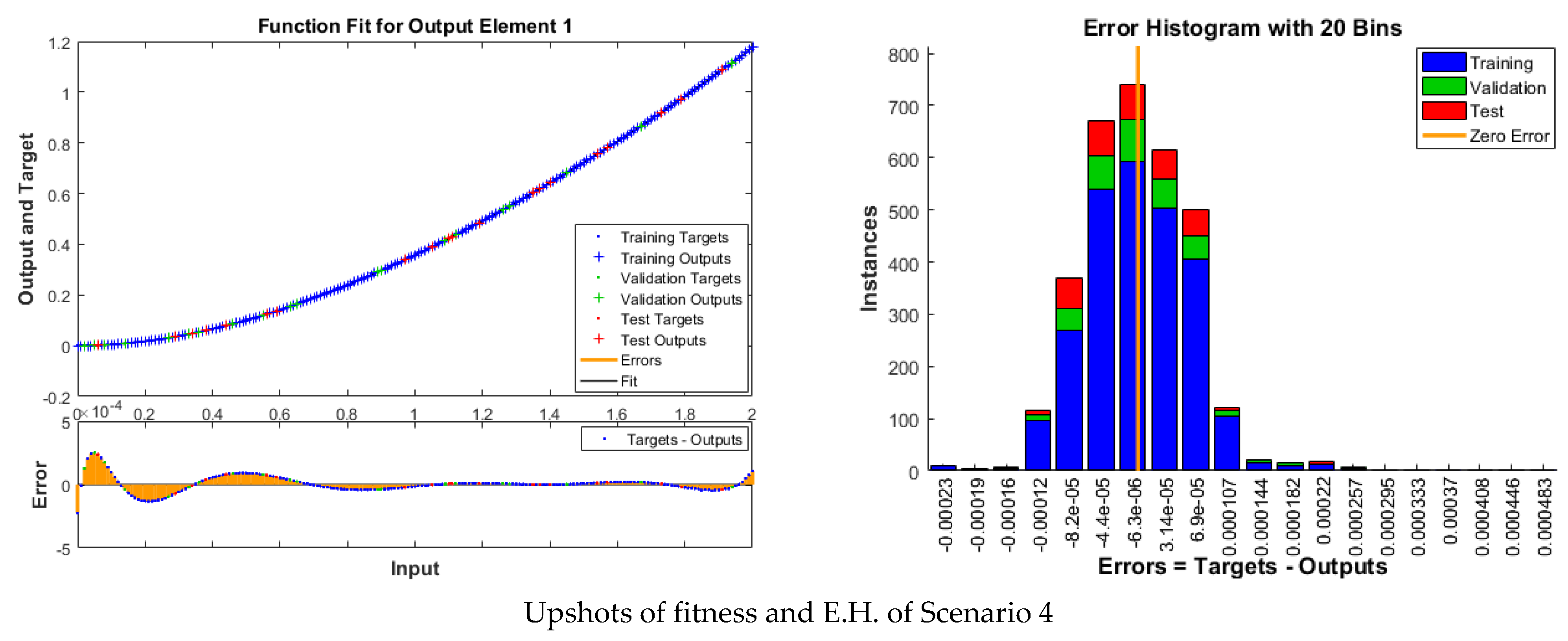


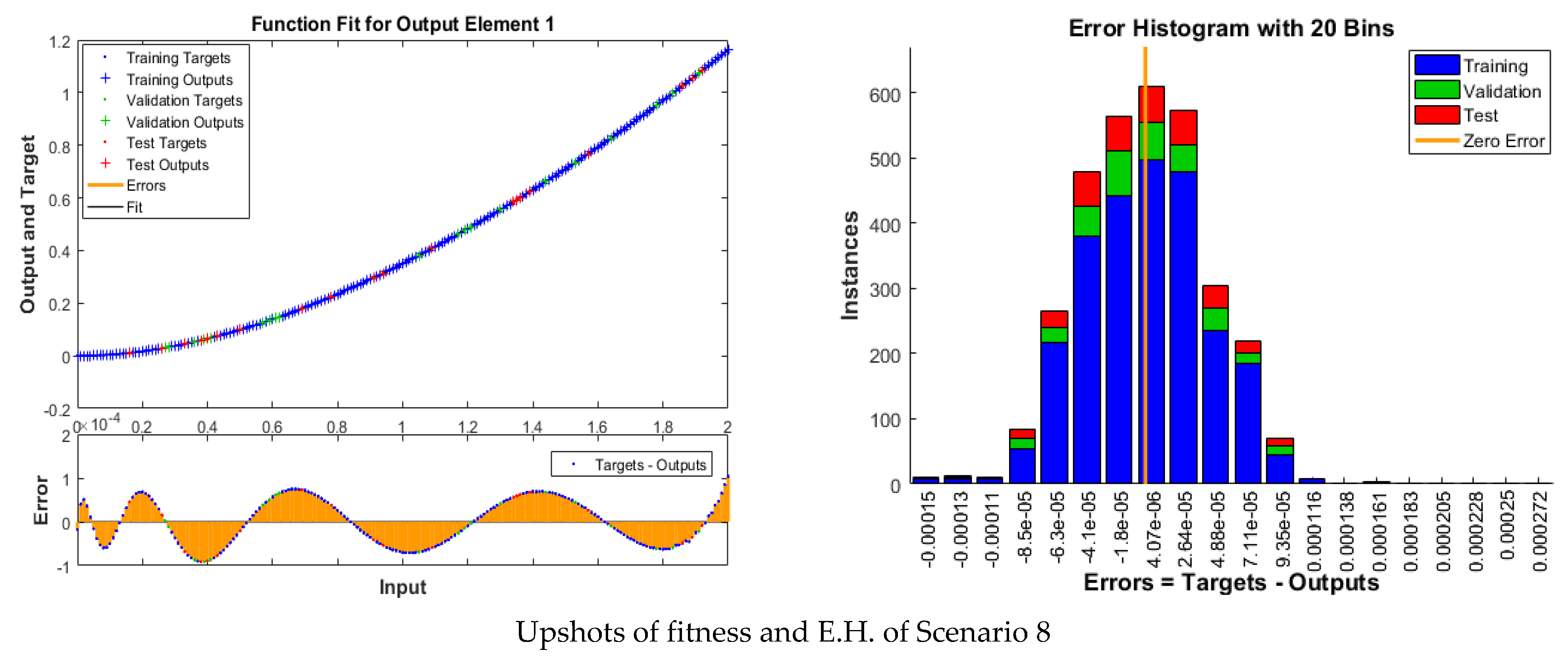
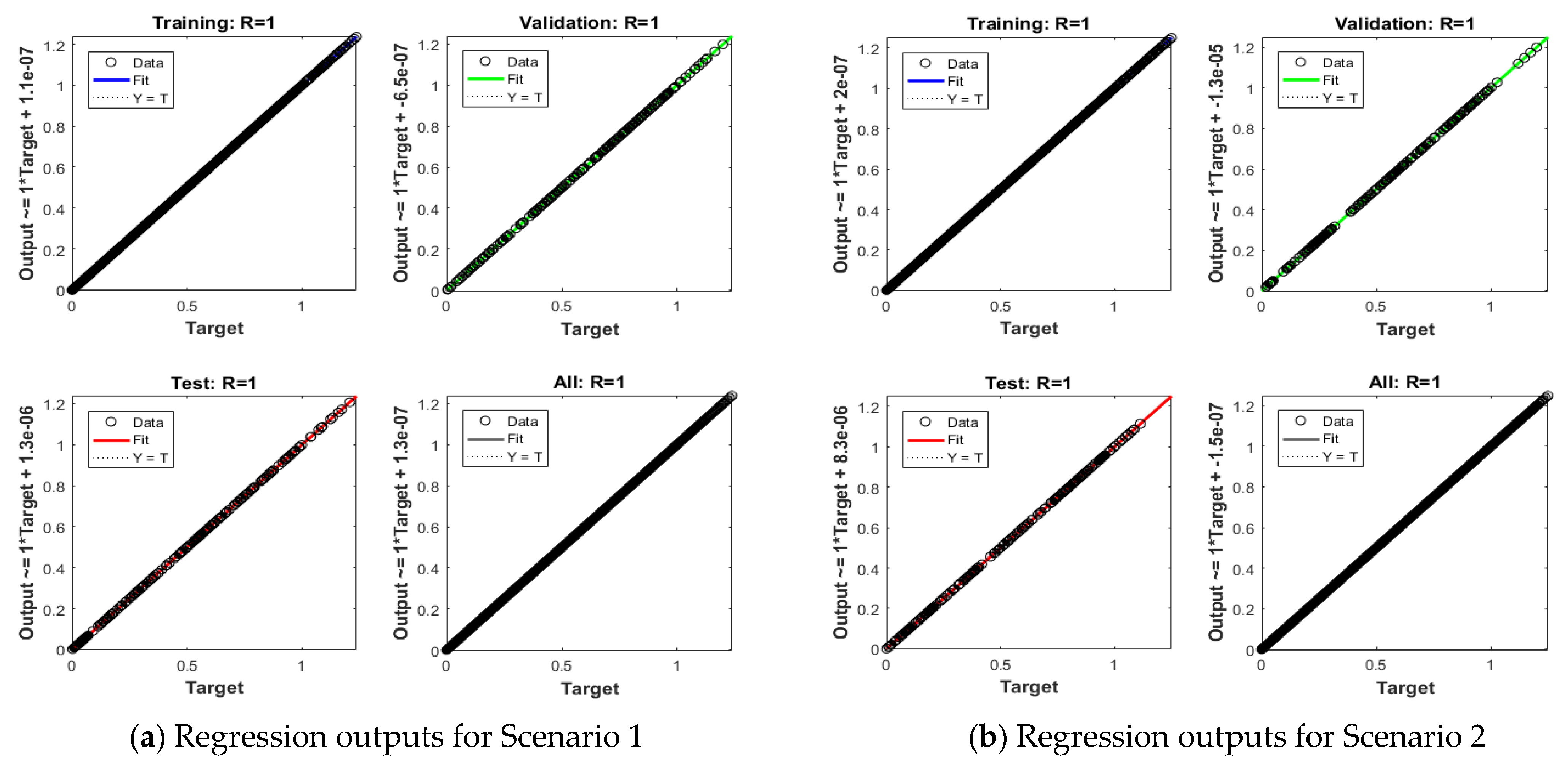
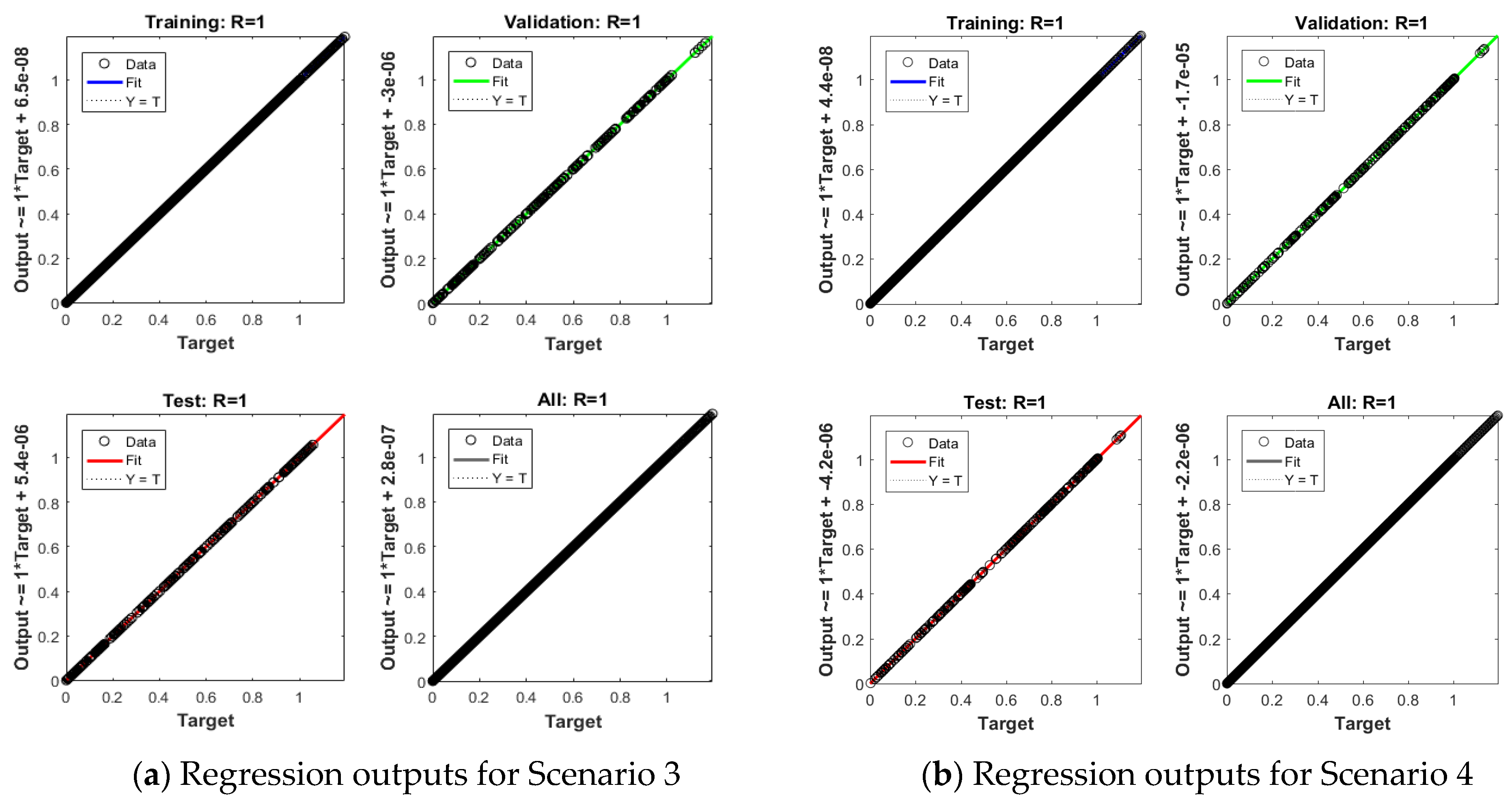
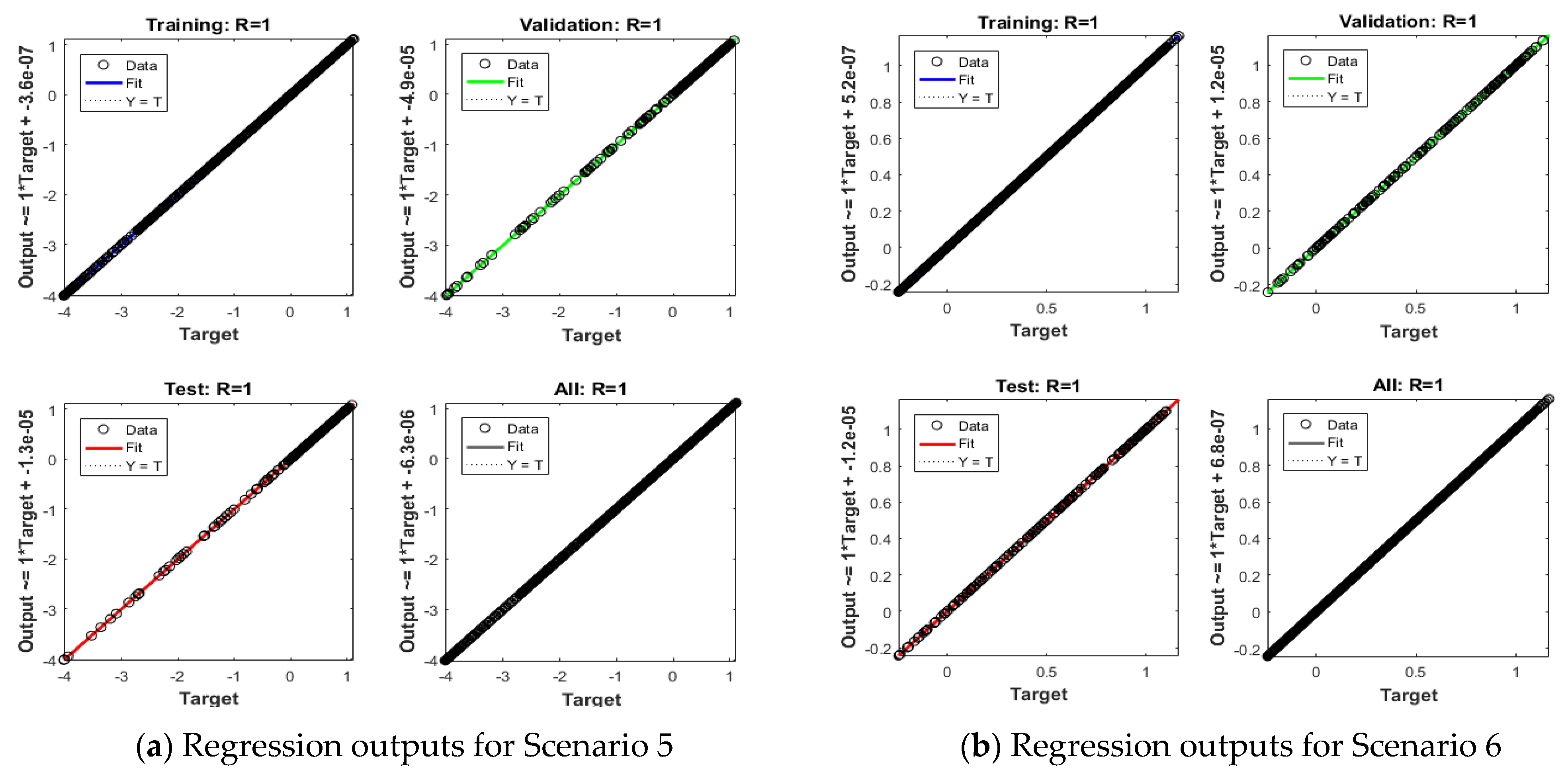
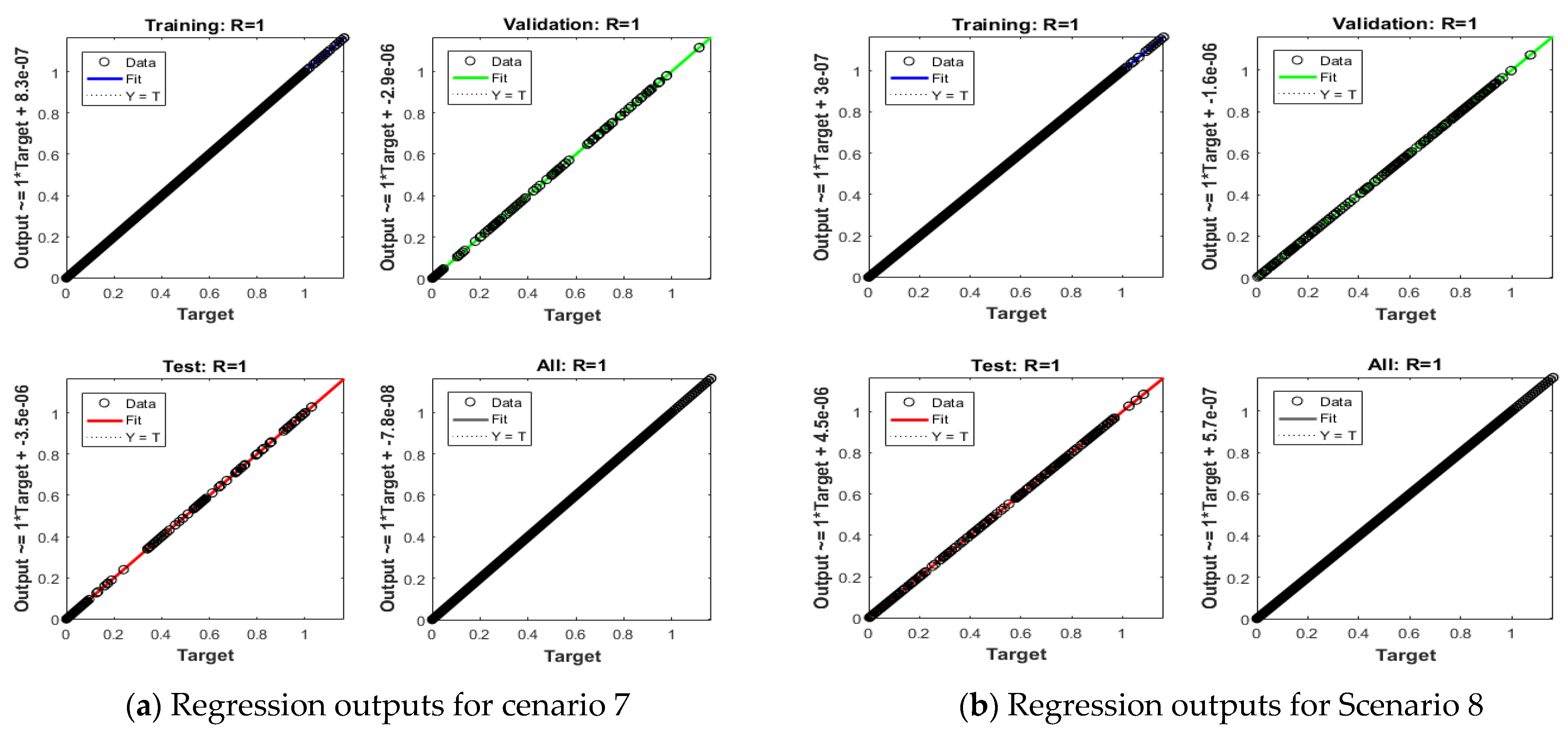
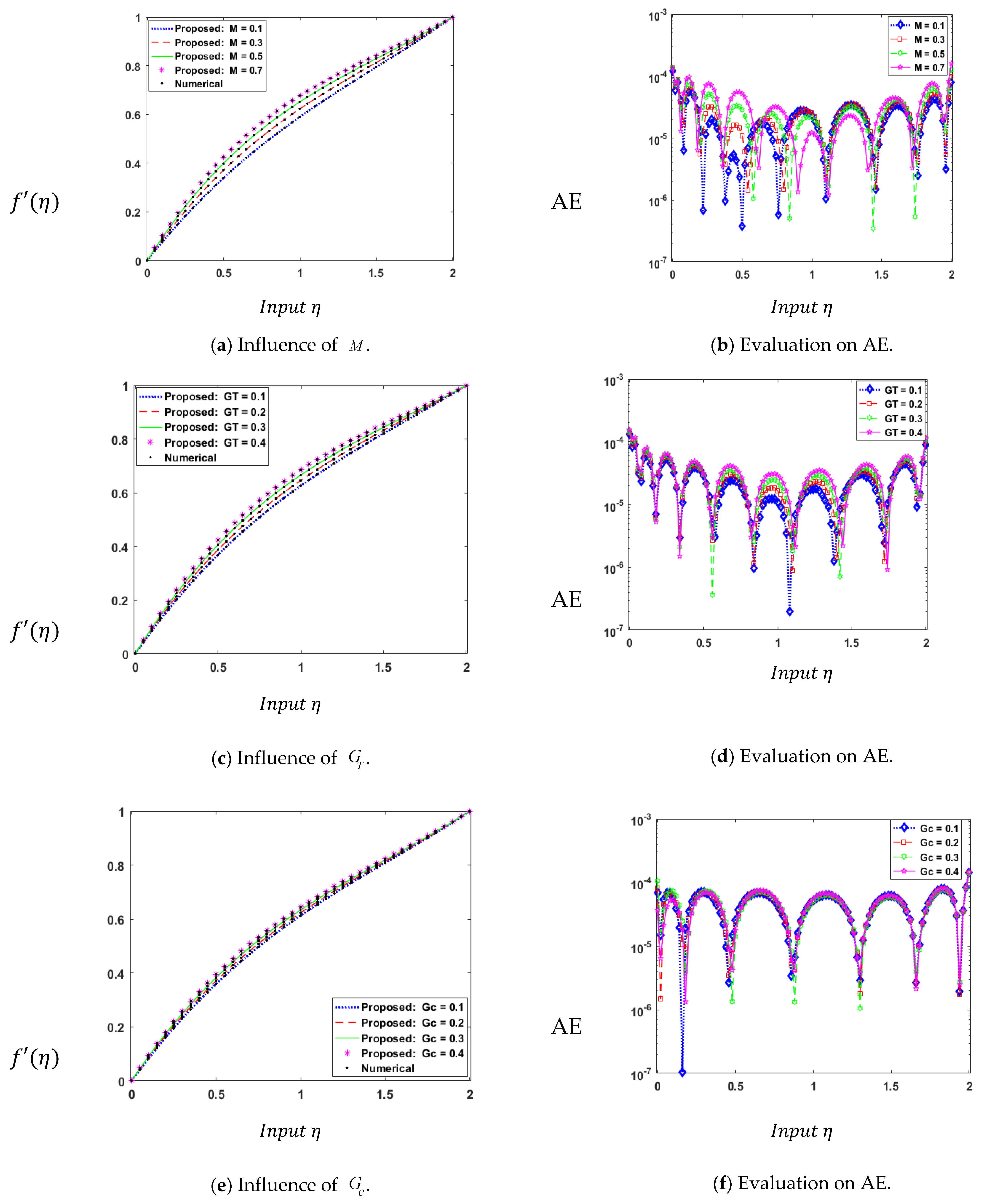
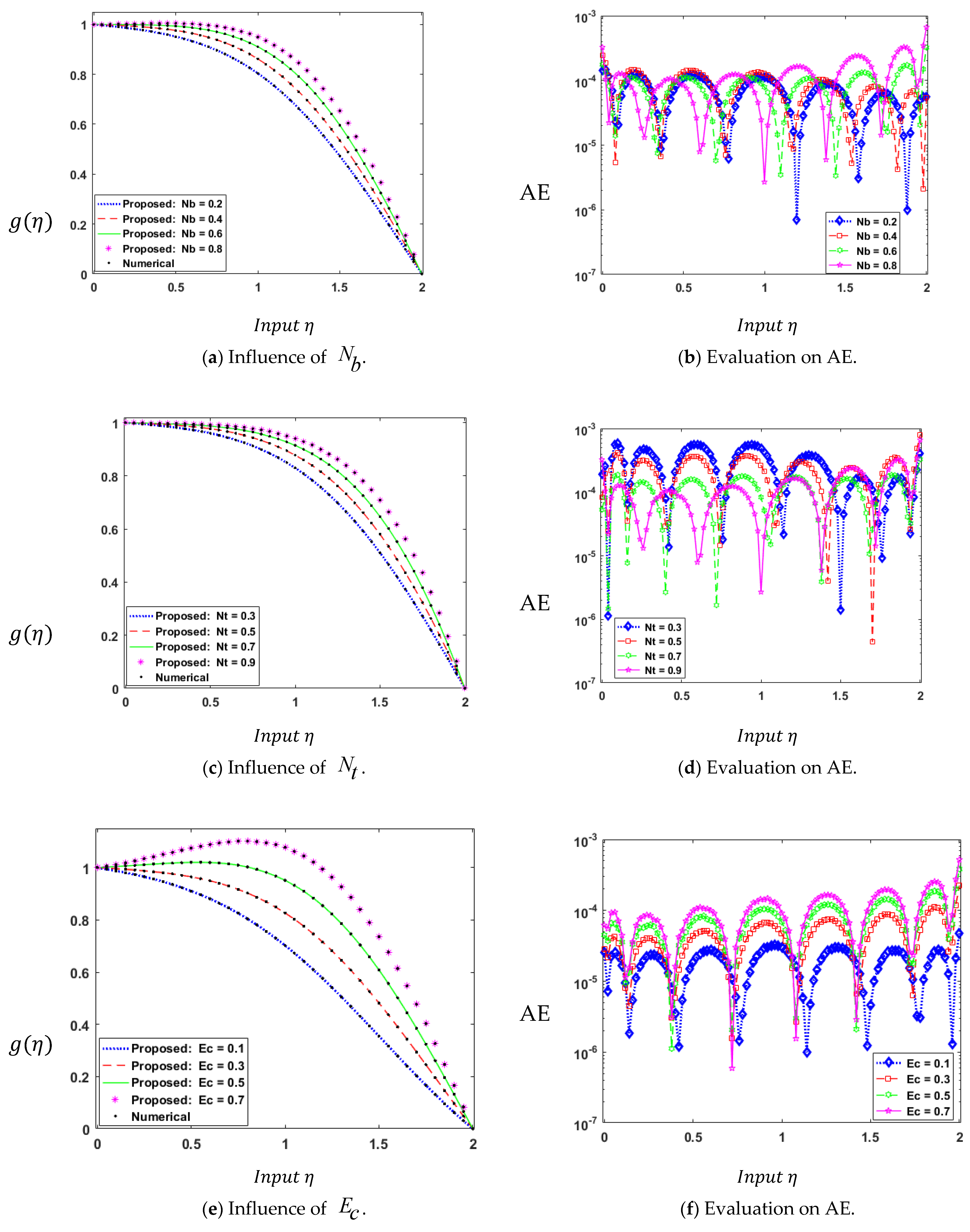

| Index | Description |
|---|---|
| Layer structure | One input, one output, and one hidden layer |
| Hidden neuron | 10–20 |
| Validation | 10-fold cross validation |
| Input grid | 201 points |
| Output grid | 16 × 201 points |
| Training samples | 80% |
| Validation samples | 10% |
| Testing samples | 10% |
| Leaning methodology | Levenberg–Marquardt |
| Label target data | Created with Adams numerical method |
| Scenarios | Cases | Physical Quantities of Concern | |||||||
|---|---|---|---|---|---|---|---|---|---|
| 1 | C1 | 0.1 | 0.2 | 0.2 | 0.1 | 0.1 | 0.3 | 0.3 | 6.5 |
| C2 | 0.3 | 0.2 | 0.2 | 0.1 | 0.1 | 0.3 | 0.3 | 6.5 | |
| C3 | 0.5 | 0.2 | 0.2 | 0.1 | 0.1 | 0.3 | 0.3 | 6.5 | |
| C4 | 0.7 | 0.2 | 0.2 | 0.1 | 0.1 | 0.3 | 0.3 | 6.5 | |
| 2 | C1 | 0.3 | 0.1 | 0.2 | 0.1 | 0.1 | 0.3 | 0.3 | 6.5 |
| C2 | 0.3 | 0.2 | 0.2 | 0.1 | 0.1 | 0.3 | 0.3 | 6.5 | |
| C3 | 0.3 | 0.3 | 0.2 | 0.1 | 0.1 | 0.3 | 0.3 | 6.5 | |
| C4 | 0.3 | 0.4 | 0.2 | 0.1 | 0.1 | 0.3 | 0.3 | 6.5 | |
| 3 | C1 | 0.3 | 0.2 | 0.1 | 0.1 | 0.1 | 0.3 | 0.3 | 6.5 |
| C2 | 0.3 | 0.2 | 0.2 | 0.1 | 0.1 | 0.3 | 0.3 | 6.5 | |
| C3 | 0.3 | 0.2 | 0.3 | 0.1 | 0.1 | 0.3 | 0.3 | 6.5 | |
| C4 | 0.3 | 0.2 | 0.4 | 0.1 | 0.1 | 0.3 | 0.3 | 6.5 | |
| 4 | C1 | 0.3 | 0.2 | 0.2 | 0.2 | 0.1 | 0.3 | 0.3 | 6.5 |
| C2 | 0.3 | 0.2 | 0.2 | 0.4 | 0.1 | 0.3 | 0.3 | 6.5 | |
| C3 | 0.3 | 0.2 | 0.2 | 0.6 | 0.1 | 0.3 | 0.3 | 6.5 | |
| C4 | 0.3 | 0.2 | 0.2 | 0.8 | 0.1 | 0.3 | 0.3 | 6.5 | |
| 5 | C1 | 0.3 | 0.2 | 0.2 | 0.1 | 0.3 | 0.3 | 0.3 | 6.5 |
| C2 | 0.3 | 0.2 | 0.2 | 0.1 | 0.5 | 0.3 | 0.3 | 6.5 | |
| C3 | 0.3 | 0.2 | 0.2 | 0.1 | 0.7 | 0.3 | 0.3 | 6.5 | |
| C4 | 0.3 | 0.2 | 0.2 | 0.1 | 0.9 | 0.3 | 0.3 | 6.5 | |
| 6 | C1 | 0.3 | 0.2 | 0.2 | 0.1 | 0.1 | 0.1 | 0.3 | 6.5 |
| C2 | 0.3 | 0.2 | 0.2 | 0.1 | 0.1 | 0.3 | 0.3 | 6.5 | |
| C3 | 0.3 | 0.2 | 0.2 | 0.1 | 0.1 | 0.5 | 0.3 | 6.5 | |
| C4 | 0.3 | 0.2 | 0.2 | 0.1 | 0.1 | 0.7 | 0.3 | 6.5 | |
| 7 | C1 | 0.3 | 0.2 | 0.2 | 0.1 | 0.1 | 0.3 | 0.1 | 6.5 |
| C2 | 0.3 | 0.2 | 0.2 | 0.1 | 0.1 | 0.3 | 0.3 | 6.5 | |
| C3 | 0.3 | 0.2 | 0.2 | 0.1 | 0.1 | 0.3 | 0.5 | 6.5 | |
| C4 | 0.3 | 0.2 | 0.2 | 0.1 | 0.1 | 0.3 | 0.7 | 6.5 | |
| 8 | C1 | 0.3 | 0.2 | 0.2 | 0.1 | 0.1 | 0.3 | 0.3 | 5.5 |
| C2 | 0.3 | 0.2 | 0.2 | 0.1 | 0.1 | 0.3 | 0.3 | 6 | |
| C3 | 0.3 | 0.2 | 0.2 | 0.1 | 0.1 | 0.3 | 0.3 | 6.5 | |
| C4 | 0.3 | 0.2 | 0.2 | 0.1 | 0.1 | 0.3 | 0.3 | 7 | |
| Scenarios | MSE Level | Execution | Gradient | Mu | Epoch | Time | ||
|---|---|---|---|---|---|---|---|---|
| Training | Validation | Testing | ||||||
| 9.249 × 10−10 | 9.709 × 10−10 | 7.092 × 10−10 | 9.25 × 10−10 | 9.99 × 10−8 | 1.00 × 10−8 | 274 | 12 | |
| 1.039 × 10−9 | 8.169 × 10−10 | 1.380 × 10−9 | 1.04 × 10−9 | 9.97 × 10−8 | 1.00 × 10−8 | 245 | 12 | |
| 1.677 × 10−9 | 1.417 × 10−9 | 1.742 × 10−9 | 1.68 × 10−9 | 9.99 × 10−8 | 1.00 × 10−8 | 433 | 32 | |
| 3.9720 × 10−7 | 4.248 × 10−9 | 4.092 × 10−9 | 3.97 × 10−9 | 9.98 × 10−8 | 1.00 × 10−8 | 574 | 31 | |
| 4.607 × 10−7 | 4.918 × 10−7 | 4.232 × 10−7 | 4.61 × 10−7 | 5.43 × 10−6 | 1.00 × 10−6 | 402 | 29 | |
| 7.368 × 10−9 | 6.517 × 10−9 | 6.931 × 10−9 | 7.37 × 10−9 | 1.02 × 10−6 | 1.00 × 10−8 | 486 | 20 | |
| 1.883 × 10−9 | 1.031 × 10−9 | 2.151 × 10−9 | 1.88 × 10−9 | 2.54 × 10−9 | 1.00 × 10−10 | 371 | 27 | |
| 1.931 × 10−9 | 2.014 × 10−9 | 2.113 × 10−9 | 1.93 × 10−9 | 9.98 × 10−8 | 1.00 × 10−8 | 282 | 12 | |
Publisher’s Note: MDPI stays neutral with regard to jurisdictional claims in published maps and institutional affiliations. |
© 2021 by the authors. Licensee MDPI, Basel, Switzerland. This article is an open access article distributed under the terms and conditions of the Creative Commons Attribution (CC BY) license (https://creativecommons.org/licenses/by/4.0/).
Share and Cite
Shoaib, M.; Khan, R.A.; Ullah, H.; Nisar, K.S.; Raja, M.A.Z.; Islam, S.; Felemban, B.F.; Yahia, I.S. Heat Transfer Impacts on Maxwell Nanofluid Flow over a Vertical Moving Surface with MHD Using Stochastic Numerical Technique via Artificial Neural Networks. Coatings 2021, 11, 1483. https://doi.org/10.3390/coatings11121483
Shoaib M, Khan RA, Ullah H, Nisar KS, Raja MAZ, Islam S, Felemban BF, Yahia IS. Heat Transfer Impacts on Maxwell Nanofluid Flow over a Vertical Moving Surface with MHD Using Stochastic Numerical Technique via Artificial Neural Networks. Coatings. 2021; 11(12):1483. https://doi.org/10.3390/coatings11121483
Chicago/Turabian StyleShoaib, Muhammad, Rafaqat Ali Khan, Hakeem Ullah, Kottakkaran Sooppy Nisar, Muhammad Asif Zahoor Raja, Saeed Islam, Bassem F. Felemban, and I. S. Yahia. 2021. "Heat Transfer Impacts on Maxwell Nanofluid Flow over a Vertical Moving Surface with MHD Using Stochastic Numerical Technique via Artificial Neural Networks" Coatings 11, no. 12: 1483. https://doi.org/10.3390/coatings11121483







